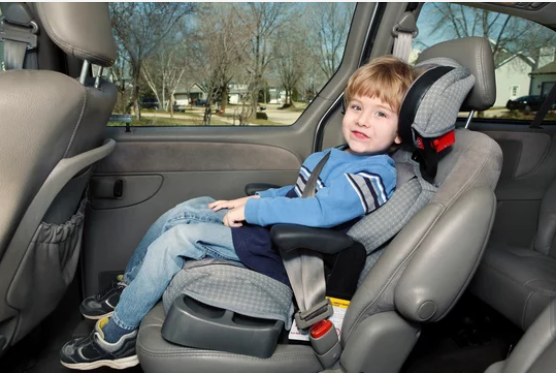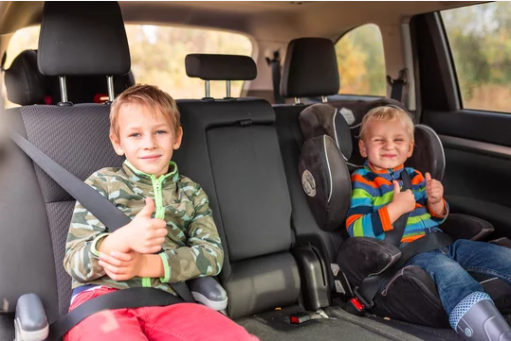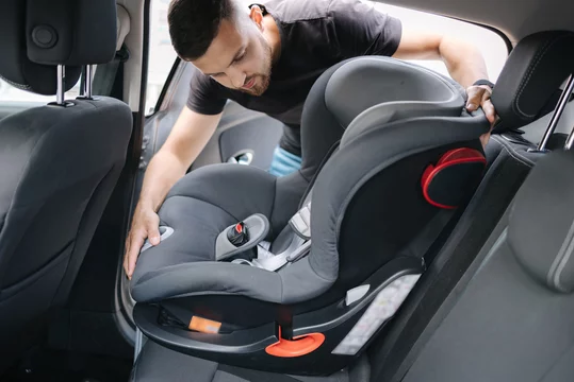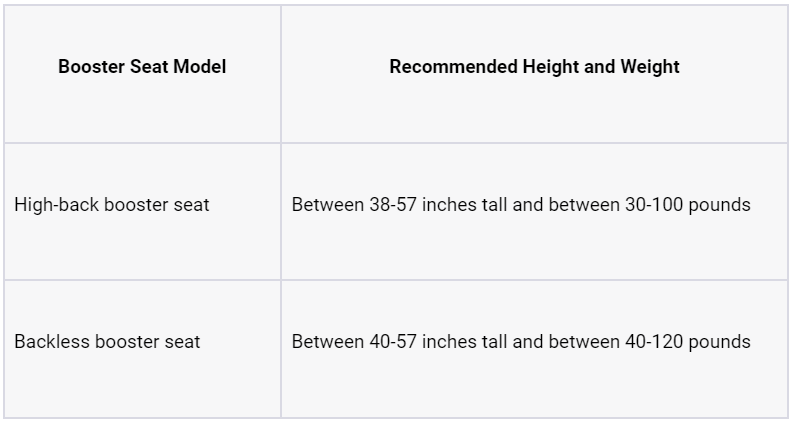How Big Should My Kid Be for a Booster Seat? Let’s Find Out
Keeping your child safe is always a priority, especially when riding in a car. Booster seats ensure your child’s safety while on the road, but it can be challenging to determine when your child is ready for one.
This article covers the importance of these vehicle safety seats to keep your child safe while in the car. We’ll cover the age, weight and height requirements for these vehicle seats and provide safety tips for choosing the right one that fits your child.
Understanding Booster Seats

Photo credit: Adobe Stock
Booster seats are a type of car seat designed to elevate your child to the right height for the seat belt to fit correctly across their body.
They are typically designed for child passengers who have outgrown their forward-facing car seats but still need to be tall enough to sit in a regular car seat with a seat belt. Two main types of infant seats are available on the market: backless and high-back child seats.
Backless Child Seat vs. High-Back Child Seat
Backless seats are simple cushions that raise the child’s seating position, fitting the seat belt properly. They are lightweight and easy to move between cars but provide less support for the child’s head and neck.
You may also like: 10 Best Baby Bouncers and Swings
High-back seats have a backrest and headrest, providing additional support and protection for your child’s head and neck. They are an excellent option for children who need more support and comfort while riding in the car.
There are also combination infant seats designed to be used as a forward-facing car seat and a booster seat. As your child grows, they can convert from a front-facing seat to a child seat.
Booster Seat Requirements
Booster seats have age, height, and weight requirements that children must meet to ensure their safety in the event of an accident. However, these requirements for infant seats vary depending on the type.
Children should generally be in a booster seat until they are at least 4 feet 8 inches tall and weigh between 90 and 100 pounds. However, following the manufacturer’s recommendations for your infant seat is essential.
Booster seats protect children in an accident by correctly positioning them in the car seat and allowing the seat belt to fit properly. If a child is not in the appropriate car seat for their age, height, or weight, they are at risk of severe injury or death in the event of a crash.
Safety Regulations for Booster Seats

Photo credit: Adobe Stock
Complying with safety regulations is crucial to ensure the safety of children traveling in cars. Using a booster seat that meets the appropriate car safety standards can significantly reduce the risk of injury or death in a car accident. In addition, failing to comply with safety regulations can result in fines or other penalties.
Different countries and regions have safety regulations for infant seats designed to ensure the safety of children traveling in cars. These regulations typically cover the design and construction of infant seats and the requirements for their use.
Here’s how a few countries and regions and their booster seat safety regulations:
United States: Booster seats are regulated by the National Highway Traffic Safety Administration (NHTSA). The NHTSA requires booster seats to meet specific car safety standards. This standard includes providing proper head and torso support and having a lap belt that sits low on the child’s hips.
European Union: The European Union ECE R44/04 safety standard regulates child boosters seats in the EU. This standard sets child seat design and testing requirements, including side-impact testing.
Australia: Child seats are regulated by the Australian Design Rules (ADR). These rules set safety requirements for child seats, such as requiring a lap-sash seat belt.
Canada: Transport Canada governs infant seat regulations. Infant seats must meet safety standards similar to those in the United States.
You may also like: 7 Travel Gear for Babies on Amazon
Risks of Using the Wrong Booster Seat
Using the wrong booster seat or not using one at all can result in potential risks for the child. The following are potential risks associated with using the incorrect infant seat or not using one at all:
- Seatbelt misplacement
- Ejection from the vehicle
- Serious injuries
- Death
Comparison of Booster Seats
Child car seats come in several brands and models. Here are some of the most popular child seats today:
Graco TurboBooster: The Graco TurboBooster seat is designed for children weighing 40–100 pounds. You can also use this as a backless booster or with a high back.
Britax Highpoint: The Britax booster seat suits children weighing 40–120 pounds. The Britax features a 10-position headrest and a SecureGuard clip for proper seat belt positioning.
Diono Monterey XT: The Diono Monterey XT is designed for children weighing 40–120 pounds and features an adjustable headrest and side-impact protection.
Chicco KidFit: The Chicco KidFit is a solid option for children weighing 30-110 pounds. It comes with a DuoZone head and shoulder side-impact protection.
Evenflo Big Kid AMP: For children between 40–110 pounds. The Evenflo features a machine-washable seat pad and two cup holders.
Choosing the Right Booster Seat for Your Child
Several factors are essential when choosing a child seat to ensure maximum driving safety. When selecting the right car seat for your child, consider the following tips based on age, height, and weight.
- Choose a seat with a high back, five-point harness, and adjustable headrest for children between 30 and 65 pounds.
- Children between 40 and 120 pounds require a high-back and backless car seat with a SecureGuard clip to help correctly position the seatbelt.
- Choose a booster seat with an adjustable headrest and shoulder belt guide for taller children to ensure proper belt-positioning booster seat.
- For younger children, choose a seat with side-impact protection and a 5-point harness to keep children safe.
- Always refer to the manufacturer’s instructions and guidelines when selecting and using a child seat to ensure maximum safety.
Installing and Using Booster Seats Correctly

Photo credit: Adobe Stock
Proper installation and use of child seats are crucial to ensure maximum safety while driving. Here are some safety tips to remember:
- Read the instructions.
- Position the seat.
- Secure your child correctly.
- Use the seat for as long as necessary.
- Avoid common mistakes.
Conclusion
Booster seats are essential safety seats that significantly protect children when traveling in a car. Children may outgrow their car seats and move on to booster seats, which can help position the seat belt correctly and offer better protection in an accident.
FAQs
1. What are the height and weight requirements for a booster seat?
The recommended height and weight for booster seats vary depending on the type of seat. The NHTSA recommends riding in a booster seat till children are at least 4 feet 9 inches tall and between 8 and 12 years of age.
Here’s a quick guide to help you:
2. How do I choose the right booster seat for my child?
When choosing a booster seat, there are various factors to consider, including age, height, weight, and type of vehicle. Here’s a list of recommended car seats for different age groups:
- Graco Affix Youth Front Seat with Latch System can fit children aged 4–10.
- Diono Monterey XT suits children aged 4–12.
- Chicco MyFit Harness + Booster Car Seat fits children aged 2–12.
- Evenflo Maestro Sport Harness Seat is recommended for children aged 2–8.
3. What should I consider when selecting a booster seat based on height and weight?
- Look for a seat with a weight limit appropriate for your child’s weight.
- Choose a high-back car seat for younger children who require additional head and neck support.
- Inspect the seat’s height and weight limits to ensure it is appropriate for your child’s height and weight.
- Consider your vehicle type and whether a high-back or backless seat is more suitable.
- Check the seat’s safety ratings to meet all applicable safety standards.
4. What are the benefits of using a booster seat for my child’s safety?
Booster seats ensure your child sits in an elevated position, properly restrained with a seat belt to provide better protection during a crash. According to the CDC, booster seats can reduce the risk of injury for children aged 4-8 by 45% compared to seat belts alone.
5. How do I fix a booster seat in my car?
Follow these steps to help you fix a booster seat in your car:
- Choose the appropriate seat for your child based on age, weight, and height.
- Read the manufacturer’s instructions carefully to ensure you properly install the booster seat.
- Put the seat in the back seat of your car in the desired seating position.
- Position the seat so that it sits flat on the car seat and the back is flush against the edge of the seat.
- Thread the seat belt through the designated guides on the booster seat. Ensure the seat belt is not twisted and flat across the child’s lap and shoulder.
- Buckle the seat belt and secure it snugly across the child’s lap and shoulder.
- Ensure you install the booster seat properly by giving it a firm shake. It should not move more than one inch in any direction.
Check out this video to install a booster seat correctly: How to properly install a booster seat.


